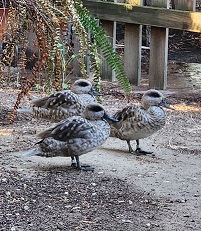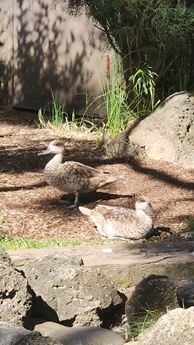Marbled Teal
Marmaronetta angustirostris
- Habitat: Wetlands, brackish waters rich in vegetation.
- Range: Fragmented distribution; eastern and western Mediterranean region, north and sub-Saharan west Africa, Iran, Pakistan and northwest India.
- Natural Diet: Aquatic plants (seeds, roots, tubers, green parts); also aquatic insects, larvae, mollusks, worms.
- Status in the Wild: THREATENED
All about the Marbled Teal
The Marbled teal are a species of duck that has a dappled appearance. They have speckled brown r bodies with dusky eye patches. Their underbellies and the feathers around their beaks are cream-colored. Their dark-color beaks are pointed and flattened along the edges. These are medium-sized ducks and are around 1.5 feet. Their short legs are positioned at the far end of their bodies and their webbed feet are an evolutionary adaptation that helps them swim more smoothly. They are monomorphous, with males and females having similar plumage, shape, and form. The males are often slightly larger than the females.
Diet/ Habitat/ Range
Marbled teal live in freshwater and brackish wetlands and man-made water bodies and are found in Europe (Germany, Spain, Hungary, Romania), Asia (Afghanistan, Armenia, Azerbaijan, China, Iran, Iraq, Israel, Jordan, Pakistan, Palestine, Syria, Turkey, Turkmenistan), and northern Africa (Algeria, Cameroon, Libya, Tunisia, Morocco).
These ducks mainly feed on aquatic plants (seeds, roots, tubers, green parts); and aquatic insects, larvae, mollusks, and worms.
Behavior
Marbled teal are known to be colonial nesters nesting next to each other in colonies. By nesting together, they reduce the likelihood of being predated upon and this is an anti-predator strategy. These ducks maintain and defend home ranges where they feed, rest, and protect their young.
Marbled Teal are ‘dabbling ducks’ feeding by tipping their bodies over into the water head-first instead of diving. They mostly feed on the surface of the water and as far as they can reach below the surface when dipping. They use their flat beaks to filter water and collect nutrients such as water weeds and microorganisms. On land, they use their beaks to funnel into the ground to capture some small crustaceans crabs, crayfishes, shrimps, prawns, krill, and barnacles), worms, and small mollusks (snails, slugs, mussels, and oysters).
Marbled teal migrate in large numbers between their breeding and wintering grounds. They communicate using a variety of vocalizations which include contact calls and alarm calls. Contact calls or long calls are emitted very often when teal are migrating and fly long distances in close formation. Other vocalizations such as “coos” are emitted during an affiliative interaction between a mother and her ducklings while a “hiss” is emitted when adult teal are protecting their nests. Marbled teal also emits alarm calls to alert the colony to the presence of a predator.
Reproduction
Marbled teals are seasonally monogamous and usually partner with only one male during the breeding season. They breed once a year with the breeding season lasting from late spring through the summer months. The ducks form into pairs when they are at their wintering grounds during the first year of their lives. These pair bonds are maintained until the breeding season ends and the female has laid her eggs. They are likely to form pair bonds with other partners during the following year’s breeding season. The pair choose a place to build their nest, usually in vegetation or in cavities along the banks of a waterbody where they are able to hide their nests, eggs, and ducklings from predators. The female Marbled Teal can lay up to 12 eggs in each clutch. While the female incubates the eggs and feeds the ducklings for till they fledge when they are around 2 months old, the male protects the female and ducklings from predators and other males. The ducklings reach sexual maturity by seven months of age.
Conservation/Status
Since Marbled Teal are heavily dependent on wetlands to survive, the loss of more than 50% of their habitats due to drainage for agriculture and dam construction has resulted in a decline in their population numbers in the wild. Due to their decreasing numbers, they are categorized as Near Threatened by the International Union for World Conservation.
The Association of Zoos and Aquariums (AZA) is focused on conserving Marbled Teal through their Species Survival Plan (SSP). Zoos across the United States, Canada, and Mexico are involved in their program and several are selected to breed their ibises to increase their population in the zoo community. AZA’s SSP is also linked with other zoos globally and several individuals have been moved internationally to add new genes to increase genetic diversity.



